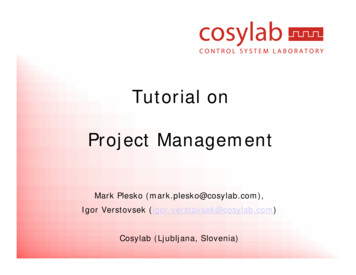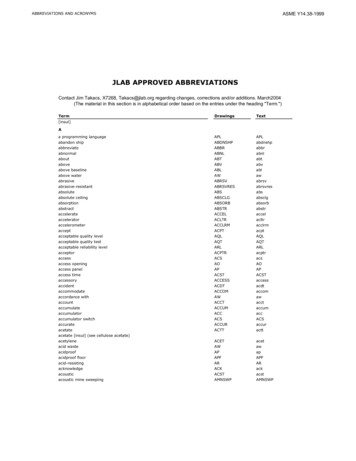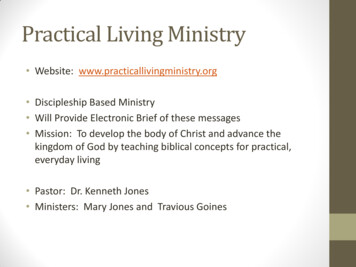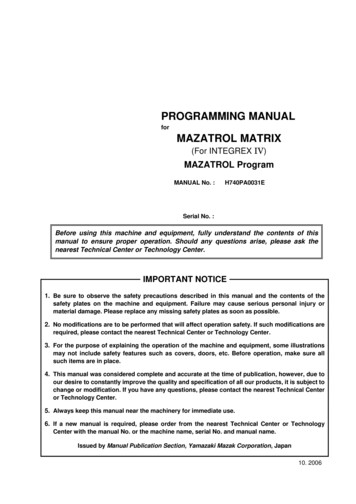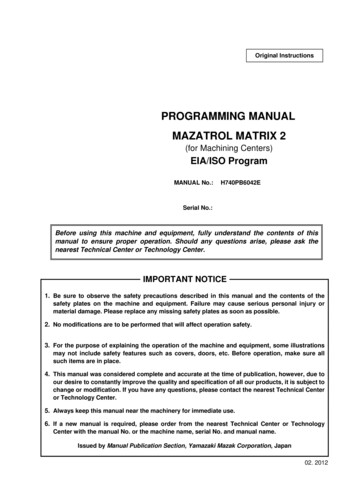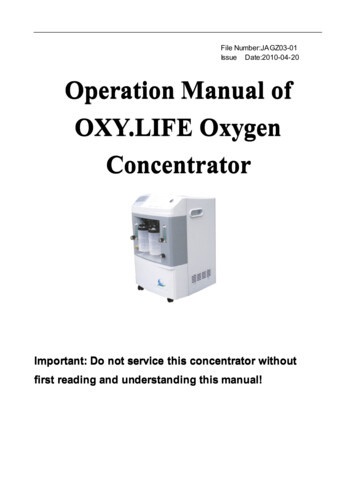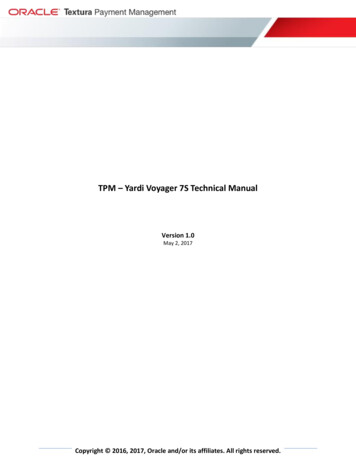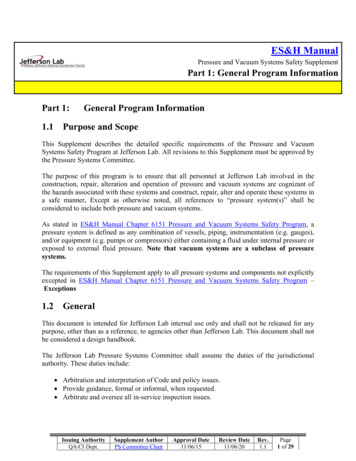
Transcription
ES&H ManualPressure and Vacuum Systems Safety SupplementPart 1: General Program InformationPart 1:1.1General Program InformationPurpose and ScopeThis Supplement describes the detailed specific requirements of the Pressure and VacuumSystems Safety Program at Jefferson Lab. All revisions to this Supplement must be approved bythe Pressure Systems Committee.The purpose of this program is to ensure that all personnel at Jefferson Lab involved in theconstruction, repair, alteration and operation of pressure and vacuum systems are cognizant ofthe hazards associated with these systems and construct, repair, alter and operate these systems ina safe manner. Except as otherwise noted, all references to “pressure system(s)” shall beconsidered to include both pressure and vacuum systems.As stated in ES&H Manual Chapter 6151 Pressure and Vacuum Systems Safety Program, apressure system is defined as any combination of vessels, piping, instrumentation (e.g. gauges),and/or equipment (e.g. pumps or compressors) either containing a fluid under internal pressure orexposed to external fluid pressure. Note that vacuum systems are a subclass of pressuresystems.The requirements of this Supplement apply to all pressure systems and components not explicitlyexcepted in ES&H Manual Chapter 6151 Pressure and Vacuum Systems Safety Program –Exceptions1.2GeneralThis document is intended for Jefferson Lab internal use only and shall not be released for anypurpose, other than as a reference, to agencies other than Jefferson Lab. This document shall notbe considered a design handbook.The Jefferson Lab Pressure Systems Committee shall assume the duties of the jurisdictionalauthority. These duties include: Arbitration and interpretation of Code and policy issues. Provide guidance, formal or informal, when requested. Arbitrate and oversee all in-service inspection issues.Issuing AuthorityQA/CI Dept.Supplement AuthorPS Committee/ChairApproval Date11/06/15Review Date11/06/20Rev.1.1Page1 of 29
ES&H ManualPressure and Vacuum Systems Safety SupplementPart 1: General Program InformationThe terms shall, should and may are used throughout this document. Shall indicates an actionthat is required or mandatory with regard to the pressure safety program. Should indicates anaction that is considered good practice in most cases, but is not considered mandatory and, insome cases, such action may not be appropriate. The term may indicates an action that is fullyoptional.1.2.1 Overview of Responsibilities for the Design Authority andSystem OwnerAll work on pressure systems and/or components considered construction, alteration, or repairshall be performed under the supervision of an assigned Jefferson Lab Design Authority(henceforth known as the DA). The DA shall be responsible for all aspects of the task that hasbeen assigned. The DA may delegate all or part of the work associated with any of these tasksbut shall not delegate any responsibility. The DA shall ensure that the overall safety of thepublic, Jefferson Lab personnel and the environment are the primary consideration of anyengineering design. The responsibilities of the DA shall terminate upon completion of allactivities related to the assigned task and the system is turned over to an assigned Jefferson LabSystem Owner.Pressure system operation (normal and off normal) and maintenance work shall be performedunder the supervision of an assigned Jefferson Lab System Owner. The System Owner is alsoresponsible for ensuring that in-service inspection of pressure systems under their purview areperformed and documented at prescribed intervals. In-service inspection of ASME PressureVessels, associated relief devices, and Category M equipment shall be coordinated andsupervised by the Vessel Inspection Coordinator. The System Owner may delegate all or part ofthe work associated with any of these tasks but shall not delegate any responsibility.1.2.2 Overview of ASME Code RequirementsThe ASME Boiler and Pressure Vessel Code (BPVC) and B31 Code for Pressure Piping are thecore of the Pressure and Vacuum Systems Safety Program. While these specific ASME Codesare usually considered to be codes of construction this program references them for maintenance,operation, design, construction, repair, alteration, etc.Pressure system design and construction initiated post 2/28/2008 shall comply with the ASMEBPV Code and/or B31 Code for Pressure Piping as applicable. Every reasonable effort shall bemade to ensure that the requirements of these ASME Codes are met. It is recognized, however,that these Codes may not directly apply to all pressure equipment or components in a system.Where the DA has determined that these Codes do not apply to a given component or system,that component or system shall be considered an Excluded Element.Issuing AuthorityQA/CI Dept.Supplement AuthorPS Committee/ChairApproval Date11/06/15Review Date11/06/20Rev.1.1Page2 of 29
ES&H ManualPressure and Vacuum Systems Safety SupplementPart 1: General Program InformationFor new construction, the Code of Record for a pressure component shall be that version (orCode year) of the most applicable ASME Pressure Code in effect 6 months prior to the start dateof the design (a later version may also be used, if available, at the discretion of the DA or ifrequired by building codes). A Code of Record shall be determined for each componentregardless of whether or not an ASME Pressure Code can be directly applied.Repairs shall comply with the original Code of Record (or, if unknown, current code in effect attime of repair), NBIC Part 3, ASME PCC-2 or other suitable post construction code. Alterationsshall comply with the ASME Code in effect at time of the alteration, NBIC Part 3, ASME PCC-2or other suitable post construction code. For repairs and alterations where codes do not directlyapply, sound engineering practices and equivalent measures shall be used.1.2.3 Interpretation of ASME Code Functions and DerivedResponsibilitiesJefferson Science Associates LLC functions as an Owner/Operator/User under the ASMEPressure Codes in its capacity as the management and operating contractor of Jefferson Lab forthe U.S. Department of Energy under Contract No. DE-ACO5-06OR23177; assuming allliability as the legal entity responsible for compliance in accordance with its Federal Contract.As such, JSA/JLAB has the overall responsibility for Code compliance and establishment ofrequirements for design, construction, examination, inspection, testing, operation, maintenance,alteration, and repair of its pressure systems.As Owner/Operator, JSA/JLAB will assign specific responsibilities and duties to its employeesacting in their capacity as employees of the Owner/Operator; specifically as the Jefferson LabDesign Authority (the DA), Jefferson Lab Inspector, Jefferson Lab System Owner, andfabricator/manufacturer/erector. The DA, System Owner, and Inspectors employed by JeffersonLab may refer to the Jefferson Lab Pressure Systems Committee for guidance, review orarbitration regarding any aspect of the performance of their duties. In performance of theirduties, the DA, System Owner, and Inspectors employed by Jefferson Lab may delegate anyfraction of the work, but shall not delegate the responsibility.1.2.3.1Responsibilities Derived from ASME B31 Piping CodesThe ASME B31 Codes define four organizations and their functions, involved in the design,fabrication, examination, inspection, testing, and operation of pressure piping. These aresummarized below:1) The Owner/Operator:i) Has overall responsibility for Code complianceii) Shall establish requirements for design, construction, examination, inspection,testing, operation, and maintenance.Issuing AuthorityQA/CI Dept.Supplement AuthorPS Committee/ChairApproval Date11/06/15Review Date11/06/20Rev.1.1Page3 of 29
ES&H ManualPressure and Vacuum Systems Safety SupplementPart 1: General Program Information2) The Designer:i) Is responsible to the owner to ensure that the design complies with Coderequirements3) The Fabricator/Erector/Manufacturer:i) Is responsible for providing materials, components, and workmanship incompliance with Code.4) The Owner’s Inspector:i) Responsible to the owner to verify that all required testing, examinations, andinspections are completeii) Verifies the fabricators quality system is acceptable and implemented and that allrequired certifications and records are complete.At Jefferson Lab, these concepts are not directly applicable. The organizations and their dutiesshall be as assigned below:The duties of the Owner/Operator shall be assumed by the Jefferson Lab Design Authority (DA)(assigned to the construction, alteration, or repair) and the Jefferson Lab System Owner assignedto the system. The overall responsibility for compliance with Code and Jefferson Lab policiesshall be assumed by the DA. The responsibility for the performance and operability of the systemshall be shared by the DA and the System Owner. The DA shall be responsible for establishingthe requirements for the engineering design, construction, operation and initial maintenance ofthe system. The System Owner shall assume full responsibility for the safe operation and longterm maintenance of the system. The responsibilities of the DA shall terminate upon completionof the construction, alteration, or repair.The duties of the Designer shall be fully assumed by the DA. The DA shall be fully responsiblefor ensuring that the engineering design complies with Jefferson Lab policy and Coderequirements where applicable.The DA shall be responsible for ensuring that duties of the Fabricator/Erector/Manufacturerare met. The DA shall be fully responsible for ensuring that the fabrication and procurement ofall components in the system comply with Jefferson Lab policy and Code requirements. Thisincludes all components fabricated off site.The duties of the Owner’s Inspector shall be assumed by one or more Jefferson Lab Inspectorsmeeting the qualifications given in Section 1.4.3. The inspector shall be an employee of theESH&Q division or a qualified individual that is independent of the fabrication, manufacturing,erection, design, testing, and examination functions.1.2.3.1.1Use of SubcontractorsThe DA (or designee under the supervision of the DA) shall serve as the SubcontractingOfficer’s Technical Representative (SOTR) for any work contracted to organizations other thanIssuing AuthorityQA/CI Dept.Supplement AuthorPS Committee/ChairApproval Date11/06/15Review Date11/06/20Rev.1.1Page4 of 29
ES&H ManualPressure and Vacuum Systems Safety SupplementPart 1: General Program InformationJefferson Lab (i.e. subcontractors). The contract shall clearly state the specific Code functionsassumed by the subcontracting agency. The DA shall take reasonable measures to ensure thatthese functions and the related requirements of the Code are fulfilled.1.2.3.2Responsibilities Derived from ASME BPVCThe ASME BPVC identifies three organizations and their specific responsibilities involved in thedesign, fabrication, examination, inspection, testing, and operation of ASME Pressure Vessels.These are summarized below:1. The Owner/Usera. It is the responsibility of the user or an agent acting on behalf of the user toprovide a certified User’s design.b. It is the user's responsibility to specify, or cause to be specified, the effectiveCode edition, Section, and Division to be used in the construction of the vessel.c. The User shall specify the performance requirements of the design specification.2. The Manufacturera. Is responsible for the structural and pressure retaining integrity of the vessel orpart thereof.b. Shall ensure that the requirements in the User’s design specification are met.3. The Inspectora. Shall be an employee of an ASME accredited Authorized Inspection Agency (ormay be employed by the manufacturer when the manufacturer is also the user).b. Shall perform the specified duties of the ASME BPVC Section and Divisionused for the vessel construction.The concepts are directly applicable at Jefferson Lab. The organizations and their duties shall beas assigned below:The duties of the Owner/User shall be jointly assumed by the DA and System Owner. The DAand System Owner shall specify the performance requirements and a certified User’s design. TheDA shall specify, or cause to be specified, the effective Code edition, Section, and Division to beused in the construction of the vessel.The Manufacturer and Inspector shall be as given by the Code Section and Division. JeffersonLab presently does not manufacture or serve as the ASME Code Inspector for any ASMEPressure Vessel or Boiler.For vessels that cannot fully comply with the ASME BPVC see Part 3: Equivalent Measures.Issuing AuthorityQA/CI Dept.Supplement AuthorPS Committee/ChairApproval Date11/06/15Review Date11/06/20Rev.1.1Page5 of 29
ES&H ManualPressure and Vacuum Systems Safety SupplementPart 1: General Program Information1.3ResponsibilitiesThis section describes the general responsibilities of individuals and groups with regard to thePressure and Vacuum Systems Safety Program. In some cases, individuals listed describefunctions rather than personnel descriptions. Specific responsibilities are given in applicablesections of this Supplement.1.3.1 Design Authority Shall ensure that the overall safety of the public, Jefferson Lab personnel and theenvironment are the primary consideration of any engineering design.Shall ensure that pressure system construction, alteration, repair and documentationmeet the requirements of this Supplement.Shall employ, as required, the expertise available through other Design Authorities, theQA/CI Inspector, the Welding Committee and the Pressure Systems Committee as wellas the experience and lessons learned documented in the Pressure Systems project filesdatabase.Shall ensure that adequate overpressure protection is provided.Shall initiate pressure system documentation in a project file consistent with therequi
time of repair), NBIC Part 3, ASME PCC-2 or other suitable post construction code. Alterations shall comply with the ASME Code in effect at time of the alteration, NBIC Part 3, ASME PCC-2 or other suitable post construction code. For repairs andalterations where codes do not directly apply, sound engineering practices and equivalent measures shall be used. 1.2.3 Interpretation of ASME Code .
